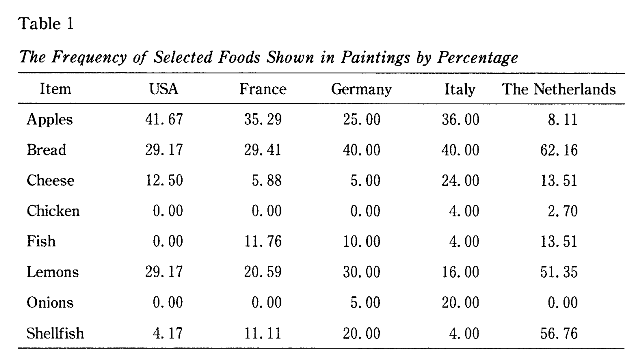問1
問題次の文章はある説明文の一部である。この文章と表を読み、下の問いの ( ) に入れるのに最も適当なものを、それぞれ下の1~4のうちから1つずつ選べ。
Art may reflect the ways people lived. Researchers have discussed how are portrays clothing and social settings. One study was conducted to determine if this idea could be extended to paintings featuring family meals. The results of this study might help illustrate why certain kinds of foods were painted. The researchers examined 140 paintings of family meals painted from the years 1500 to 2000. These came from five countries: the United States, France, Germany, Italy, and the Netherlands. The researchers examined each painting for the presence of 91 foods, with absence coded as 0 and presence coded as 1. For example, when one or more onions appeared in a painting, the researchers coded it as 1. Then they calculated the percentage of the paintings from these countries that included each food.
問1
For the category “Apples” in this research, a painting with two whole apples and one apple cut in half would be labeled as ( ).
- 0
- 1
- 2
- 3
【解説】
「この研究で「リンゴ」のカテゴリでは、2つの丸いリンゴと1つのリンゴを半分に切った絵は ( ) とラベル付けされます」
本文にこうあります。
The researchers examined each painting for the presence of 91 foods, with absence coded as 0 and presence coded as 1.
「研究者は91の食品の有無を調べるために、ないときは0として記号化し、あるときは1として記号化し、それぞれの絵を検査しました」
これだけでも正解を選べるかと思いますが、よくわからないときのために、次の文で具体例が示されています。
For example, when one or more onions appeared in a painting, the researchers coded it as 1.
「たとえば、1つ以上の玉ねぎが絵に現れたとき、研究者たちはそれを1と記号化しました」
数はどうあれ、存在しさえすれば「1」とあらわされるので、リンゴが2つであろうが、半分であろうが「1」とあらわされます。
【正解】2
問2
問題次の文章はある説明文の一部である。この文章と表を読み、下の問いの ( ) に入れるのに最も適当なものを、それぞれ下の1~4のうちから1つずつ選べ。

問2
According to Table 1, the paintings from ( ).
1. France included apples at a lower percentage than the German ones
2. France included cheese at a higher percentage than the Dutch ones
3. Italy included bread at a lower percentage than the American ones
4. Italy included onions at a higher percentage than the German ones
【解説】
「表1によると、( )」
この問題は、表1を見て解く問題です。本文は読まなくてよいですね。
1. France included apples at a lower percentage than the German ones
「フランスはドイツよりも、リンゴを含む割合は低かった」
フランスのリンゴは「35.29%」、ドイツは「25.00%」です。フランスの方が高いので、この選択肢は違います。
2. France included cheese at a higher percentage than the Dutch ones
「フランスはオランダよりも、チーズを含む割合が高かった」
フランスのチーズは「5.88%」、オランダは「13.51%」です。フランスの方が低いので、この選択肢は違います。
3. Italy included bread at a lower percentage than the American ones
「イタリアはアメリカよりも、パンを含む割合が低かった」
イタリアのパンは「40.00%」、アメリカは「29.17%」です。イタリアの方が高いので、この選択肢は違います。
4. Italy included onions at a higher percentage than the German ones
「イタリアはドイツよりも、玉ねぎを含む割合が高かった」
イタリアの玉ねぎは「20.00%」、ドイツは「5.00%」です。イタリアの方が高いので、この選択肢が正解です。
表に印をしながら落ち着いてやれば大丈夫ですね。
【正解】4
問3
問題次の文章はある説明文の一部である。この文章と表を読み、下の問いの ( ) に入れるのに最も適当なものを、それぞれ下の1~4のうちから1つずつ選べ。
Table 1 shows the percentage of paintings with selected foods. The researchers discussed several findings. First, some paintings from these countries included foods the researchers had expected. Shellfish were most common in the Netherlands’ (Dutch) paintings, which was anticipated as nearly half of its border touches the sea. Second, some paintings did not include food the researchers had expected. Shellfish and fish each appeared in less than 12% of the paintings from the United States, France, and Italy although large portion of these countries border oceans or seas. Chicken, a common food, seldom appeared in the paintings. Third, some paintings included foods the researchers had not expected. For example, among German paintings, 20% of them included shellfish although only 6% of the country touches the sea. Also, lemons were most common in paintings from the Netherlands, even though they do not grow there naturally.

問3
According to the passage and Table 1, ( ).
1. chicken frequently appeared in the American paintings because people there often ate chicken
2. fish appeared in less than one tenth of the Italian paintings though much of Italy lies next to seas
3. lemons appeared in more than half of the Dutch paintings as they are native to the Netherlands
4. shellfish appeared in half of the paintings from each of the five countries because they touch seas
【解説】
「文章と表1によると ( )」
1. chicken frequently appeared in the American paintings because people there often ate chicken
「チキンはアメリカの絵画に頻繁に登場しました」
チキンに関しては、本文にこうあります。
Chicken, a common food, seldom appeared in the paintings.
「一般的な食べ物であるチキンは、絵にはめったにあらわれません」
表1を見ても、アメリカのチキンは「0.00%」です。ということで、この選択肢は違います。
2. fish appeared in less than one tenth of the Italian paintings though much of Italy lies next to seas
「イタリアの大部分は海の隣にありますが、魚はイタリアの絵画の1/10未満しかあらわれませんでした」
魚に関しては、本文にこうあります。
Shellfish and fish each appeared in less than 12% of the paintings from the United States, France, and Italy although large portion of these countries border oceans or seas.
「これらの国の大部分は海洋または海に接していますが、貝や魚は、米国、フランス、イタリアの絵画の12%未満しかあらわれませんでした」
この文からイタリアの大部分は海に接していることは分かります(地図を思い浮かべてもそれは分かりますけれどね)。ですがこの文だけでは、イタリアの絵が1/10未満とは言えません。
表1を見てみると、イタリアの魚は「4.00%」です。これは1/10未満ですね。したがってこの選択肢が正解です。
3. lemons appeared in more than half of the Dutch paintings as they are native to the Netherlands
「レモンはオランダ原産なので、オランダの絵画の半分以上にあらわれていました」
表1によると、オランダのレモンは「51.35%」と、半分以上あらわれています。ですが、レモンに関しては、本文にこうあります。
Also, lemons were most common in paintings from the Netherlands, even though they do not grow there naturally.
「また、レモンはオランダでは自然に育ちませんが、オランダの絵画では最も一般的でした」
「レモンが絵画の半分以上にあらわれている」という部分は合っているのですが、選択肢の they are native to the Netherlands の部分が本文と一致しません。ということで、この選択肢は違います。
4. shellfish appeared in half of the paintings from each of the five countries because they touch seas
「海に接しているので、貝は5か国の絵画の半分にあらわれました」
貝に関しては、選択肢 2. の時に確認しましたが、本文には「貝や魚は、米国、フランス、イタリアの絵画の12%未満しかあらわれませんでした」とあります。
また表1を見ると半分といえるのはオランダの「56.76%」くらいで、その他は「4.17%」「11.11%」「20.00%」「4.00%」と、とても半分というレベルではありません。
ということで、この選択肢は違います。
【正解】2
問4
問題次の文章はある説明文の一部である。この文章と表を読み、下の問いの ( ) に入れるのに最も適当なものを、それぞれ下の1~4のうちから1つずつ選べ。
Comparing these results with previous research, the researchers concluded that food are does not necessarily portray actual life. The researchers offered some explanations for this. One explanation is that artists painted some foods to express their interest in the larger world. Another is that painters wanted to show their technique by painting more challenging foods. For example, the complexity of a lemon’s surface and interior might explain its popularity, especially among Dutch artists. As other interpretations are possible, it is necessary to examine the paintings from different perspectives. These are the period in which the paintings were completed and the cultural associations of foods. Both issues will be taken up in the following sections.
(Brian Wansink 他(2016) Food Art Does Not Reflect Reality: A Quantitative Content Analysis of Meals in Popular Paintings の一部を参考に作成)
問4
According to the passage, foods in these paintings can ( ).
1. demonstrate the painters’ knowledge of history
2. display the painter’s desire to stay in their countries
3. indicate the painters’ artistic skills and abilities
4. reflect the painters’ love of their local foods
【解説】
「その文によると、これらの絵画の中の食べ物は ( ) ことができる」
1. demonstrate the painters’ knowledge of history
「歴史に対する画家の知識を証明する」
本文には「絵が描かれた時代という視点からも調べる必要がある」と書かれてあります。しかしそれに関しては次のセクションで取り上げるとありますので、今回の問題には関係ありません。
2. display the painter’s desire to stay in their countries
「自国にとどまりたいという画家の願望を示す」
本文にこうあります。
One explanation is that artists painted some foods to express their interest in the larger world.
「アーティストがより大きな世界への関心を表すためにいくつかの食品を描いたという説明があります」
選択肢と逆の内容ですね。ということで、この選択肢は違います。
3. indicate the painters’ artistic skills and abilities
「画家の芸術的スキルと能力を示す」
本文にこうあります。
Another is that painters wanted to show their technique by painting more challenging foods.
「画家がより挑戦的な食べ物を描くことによって彼らの技術を見せたかったという別の説明があります」
ということで、この選択肢が正解です。
4. reflect the painters’ love of their local foods
「地元の食品に対する画家の愛情を反映する」
問3で確認しましたが、ドイツの「貝」や、オランダの「レモン」のように、地元でとれないものが描かれることが多いものもありましたね。この選択肢は違います。
【正解】3



コメントをどうぞ